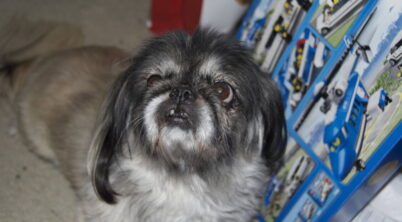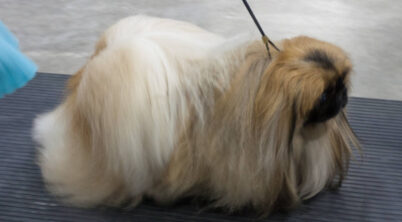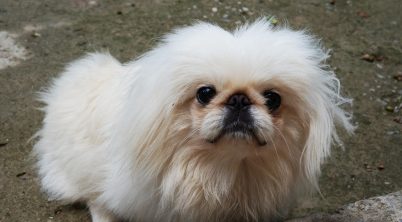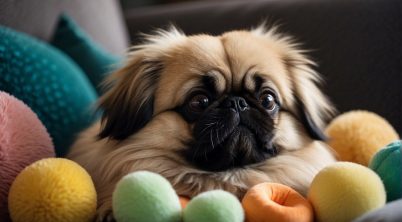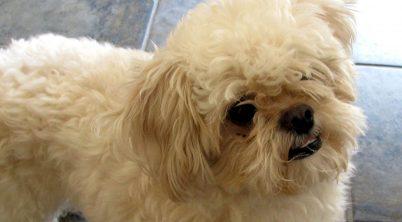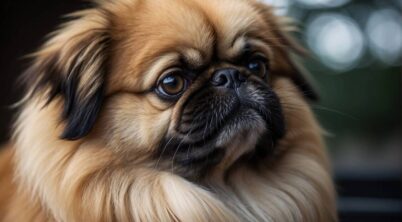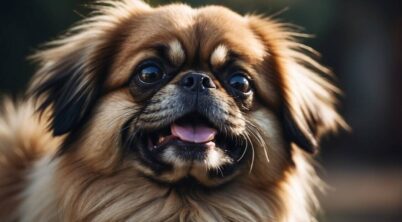The Pekingese Teacup, or Miniature Pekingese, represents a small-sized version of the traditional Pekingese breed, a toy breed with a rich history that traces back to ancient China. Esteemed for their compact size and companionship qualities, these dogs were once cherished by Chinese royalty and often referred to as “Sleeve Pekingese” due to the practice of carrying them in the ample sleeves of royal garments. The breed’s transition from Chinese palaces to western society occurred during the 19th century, where they were introduced to Britain and subsequently gained popularity across Europe.
Renowned for their lion-like mane and confident demeanor, Teacup Pekingese maintain the characteristics of their larger counterparts, including a flat face and a luxurious double coat. They are classified as companion animals and have been selectively bred to achieve their diminutive stature. The Pekingese Teacup typically stands less than six inches at the shoulder and weighs under seven pounds, distinguishing them from the standard Pekingese in size alone.
While their size may be small, the personality and care requirements of the Teacup Pekingese are as substantial as any other dog’s. Prospective owners should be aware that, despite their refined appearance, these miniaturized Pekingese require regular grooming and are known for their independent spirit. This toy breed thrives on affection and is well-suited to the lifestyle of those able to offer close companionship and attentive care.
Table of Contents
Pekingese Teacup
The Pekingese Teacup is a miniature version of the well-established Pekingese breed, hailing from China. These dogs carry the nickname “Sleeve Pekingese” or “Mini Pekingese,” a nod to their size and historical practice of being carried in the large sleeves of Chinese imperial family members.
Size and Appearance:
- Height: Typically less than 6-9 inches
- Weight: Ranges between 4-6 pounds
- Features: Flat-faced with a luxurious coat
Origin and History: The breed’s western debut happened in the late 19th century when Pekingese were brought to Britain after the Second Opium War. British soldiers returning from China brought these dogs, elevating them to a status symbol among Europe’s elite.
Characteristics:
- Temperament: Affectionate, docile, yet dignified
- Lifespan: Can live up to 15 years with proper care
- Grooming Needs: High due to their lush coat
Health Considerations: Despite their small stature, Pekingese Teacups are relatively hardy. It’s imperative for potential owners to be aware of the breed’s specific health considerations, such as respiratory issues due to their brachycephalic (flat-faced) nature.
In summary, the Pekingese Teacup is a diminutive, yet regal companion, boasting a storied history and requiring dedicated care. They are valued for both their compact size and their loving temperament.
Origin and History
The Pekingese breed, often referred to as “Lion Dogs,” has its origins steeped in the rich tapestry of Ancient China. This toy-sized breed is believed to have been cultivated by Chinese Royalty for centuries, embodying a small canine that reflected the majestic qualities of the lion, which is a symbol of courage and nobility in Chinese culture.
The exact timeline of the Pekingese’s development is shrouded in the distant past, with the lineage purportedly dating back over 2,000 years. These regal dogs enjoyed a pampered existence within the Chinese imperial family and were so exclusive that they resided in the opulent Forbidden City in Beijing.
The Dynasty’s Companions
- Held in high esteem by emperors and empresses
- Known for their role as lapdogs and esteemed companions
- Often transported in the sleeves of robes, giving rise to the term “Sleeve Pekingese“
European Discovery
During the Second Opium War, soldiers breached the walls of Yuanmingyuan, leading to the Pekingese’s eventual dispersion to England. Here, they garnered immediate affection among the British nobility.
Recognition
By the early 20th century, Pekingese dogs had made their way across the Atlantic, capturing the hearts of dog enthusiasts in the United States. The American Kennel Club officially recognized the breed in 1906, cementing its status as a cherished companion on both sides of the ocean.
In modern times, the teacup variety of the Pekingese emerged, maintaining the breed’s storied legacy while appealing to those desiring a more diminutive companion that still carried the dignified air of its larger ancestors.
Breed Characteristics
The Teacup Pekingese is a distinct variety of the Pekingese breed, notable for its small size and bold personality. This section explores the specific physical and personality traits that characterize these miniature dogs.
Physical Appearance
Teacup Pekingese dogs are renowned for their compact body and substantial fur. Their adult size usually doesn’t exceed the following dimensions:
- Height: Typically less than 6 to 9 inches at the shoulder
- Weight: Generally ranges between 3 to 6 pounds
Their coat is long and flows, often requiring regular grooming to maintain its elegance. Coat colors in this breed can be diverse, including shades of gold, red, or sable, often with a variety of markings.
Physical Features:
- Head: They have a relatively flat face with a prominent forehead.
- Eyes: Large, round, and typically dark, exuding a sense of alertness.
- Ears: Heart-shaped, set high and draped with long fur.
- Tail: High-set and carried over their back, adorned with plentiful feathering.
Personality Traits
Personality and temperament greatly define the Teacup Pekingese. Despite their diminutive stature, they often showcase traits such as:
- Affectionate: Extremely loving with their family members, often seeking attention and interaction.
- Loyal and Intelligent: Quick to learn and devoted to their owners.
- Stubborn: They can be willful, necessitating patient and consistent training.
- Independent and Vocal: Their confidence leads them to enjoy time alone but also be expressive when they desire attention or if something is amiss.
Behavioral Notes:
- Elegant and Proud: They carry themselves with a regal demeanor reflective of their imperial heritage.
- Dignified: Command respect through their bold and self-assured attitudes.
- Alert: Make excellent watchdogs due to their keen awareness of their surroundings.
Health and Care
Pekingese dogs, especially the Teacup variety, come with specific health and care considerations. They are prone to certain health problems that owners should monitor carefully.
Common Health Issues:
- Respiratory Problems: Due to their short muzzles, they may suffer from brachycephalic syndrome, which can cause breathing difficulties.
- Dental Problems: Small breeds often have crowded teeth, increasing the risk of periodontal disease. Regular dental checks are essential.
- Obesity: With a propensity for weight gain, maintaining a proper diet and exercise regimen is vital to prevent obesity-related health complications.
The lifespan of a Teacup Pekingese ranges, with proper care, they can enjoy a full and happy life.
Grooming Needs:
- Shedding: Regular grooming is necessary to manage their long, flowing coats and to prevent matting.
- Brushing: They should be brushed several times a week with a suitable brush to remove loose fur and debris.
Exercise Needs:
- Despite their small size, Teacup Pekingese require daily exercise to stay healthy. However, due to their size, they should engage in moderate activities to avoid overexertion.
Care Tips:
- Monitor for signs of overheating during exercise, as they are sensitive to high temperatures.
- Keep them on a balanced diet, measured to their size and energy levels, to prevent overfeeding.
Effective care ensures these dogs lead comfortable, healthy lives. Regular vet visits are crucial to manage any health concerns of Teacup Pekingese.
Training and Socialization
When embarking on training a Teacup Pekingese, it’s crucial to understand their trainability and intelligence. They possess an independent nature, which may pose a challenge; however, they are quite capable of learning. Owners are advised to adopt a gentle and consistent approach, utilizing positive reinforcement methods such as praise and treats.
Socialization should start early, as it helps the Teacup Pekingese become confident with strangers, kids, and other pets. To foster a well-adjusted demeanor, introduce the dog to a variety of people and situations progressively.
Table 1: Training and Socialization Tips
| Aspect | Tips |
|---|---|
| Training | Use positive reinforcement. Avoid harsh methods. |
| Socialization | Introduce to people and pets gradually. |
Teacup Pekingese may not be overly eager to please, but finding the right motivation is key to training. Though small, they are a good fit for families, seniors, and singles due to their size and temperament. They often form strong bonds with their owners and can coexist peacefully with cats and other pets if socialized properly.
To summarize, while the Teacup Pekingese may require patience and perseverance during training, they can learn to be obedient. With consistent effort and a clear understanding of their personality, these dogs can become well-mannered companions.
Breeding and Selection
When selecting for breeding Teacup Pekingese, which is often referred to as “Sleeve Pekingese” or “Mini Pekingese,” breeders should prioritize health and temperament. Although the American Kennel Club (AKC) does not officially recognize “Teacup” as a separate breed category, these dogs fall within the Toy Group and are essentially smaller versions of the standard Pekingese or “Pelchie Dog,” historically known as the “Peking Palasthund.”
Breeding Considerations:
- Health: A breeder should ensure that both parent Pekingese have no genetic disorders and are screened for health issues common to small dogs.
- Size: The goal of breeding Teacup Pekingese is to produce healthy puppies that are compact in size (typically under 6 pounds).
- Temperament: Breeders should select Pekingese parents with a calm, affectionate nature suitable for a companion or family dog.
Responsible Breeding Practices:
- Avoid breeding dogs with extreme physical characteristics that could compromise their health.
- Promote socialization and proper care from an early age to ensure the puppies have a well-adjusted temperament.
Selecting a Puppy:
- Potential owners should seek Pekingese puppies from reputable breeders who follow ethical breeding practices.
- Breeders can guide buyers in selecting a puppy that will suit apartment living and serve as a loyal companion and a competent watchdog.
Teacup Pekingese are not classified as hypoallergenic, and their luxurious coat requires regular grooming. These pocket-sized dogs fit well into apartment living and may have a watchful nature that can sometimes border on being aggressive if not properly trained. Breeders and new owners alike must be aware that, despite their small stature, Teacup Pekingese require the same level of commitment as larger breeds regarding training, socialization, and healthcare.
* Banner photo by Schauleh Vivian Sahba, cropped | Some rights reserved

